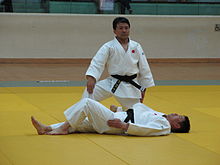|
Katame-no-kata
Katame no Kata (固の形, Forms of grappling) is one of the two Randori-no-kata (乱取りの形, Free practice forms) of Kodokan Judo. It is intended as an illustration of the various concepts of katame-waza (固技, grappling techniques) that exist in judo, and is used both as a training method and as a demonstration of understanding. HistoryThe katame-no-kata was developed by Jigoro Kano as a method of illustrating principles of grappling to allow students to more effectively apply them in randori. Initially, the kata consisted of ten techniques. These were subsequently appended, bringing the number to fifteen.[1] The Katame no Kata was developed at the Kodokan between 1884 and 1887 following the development of the Nage no Kata. It is composed of three groups of grappling techniques each with five representative techniques. Your goal is to acquire the methods of controlling your opponent in your practice of Katame No Kata. DescriptionThe katame-no-kata consists of fifteen techniques, grouped in three categories:
Osae-komi-wazaThe five holding techniques demonstrated in Katame no Kata are:
Shime wazaThe five chokes demonstrated are:
Kansetsu wazaThe five joint locks demonstrated are:
Videos of katame-no-kata
References
External links
|
||||||||||||||||||
Portal di Ensiklopedia Dunia
